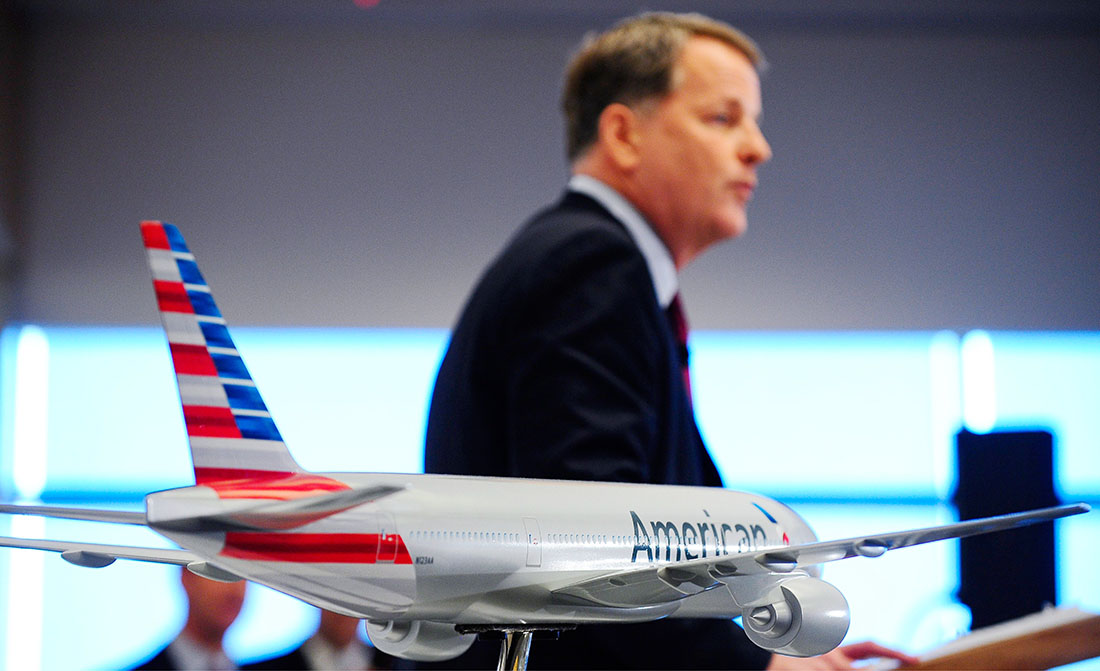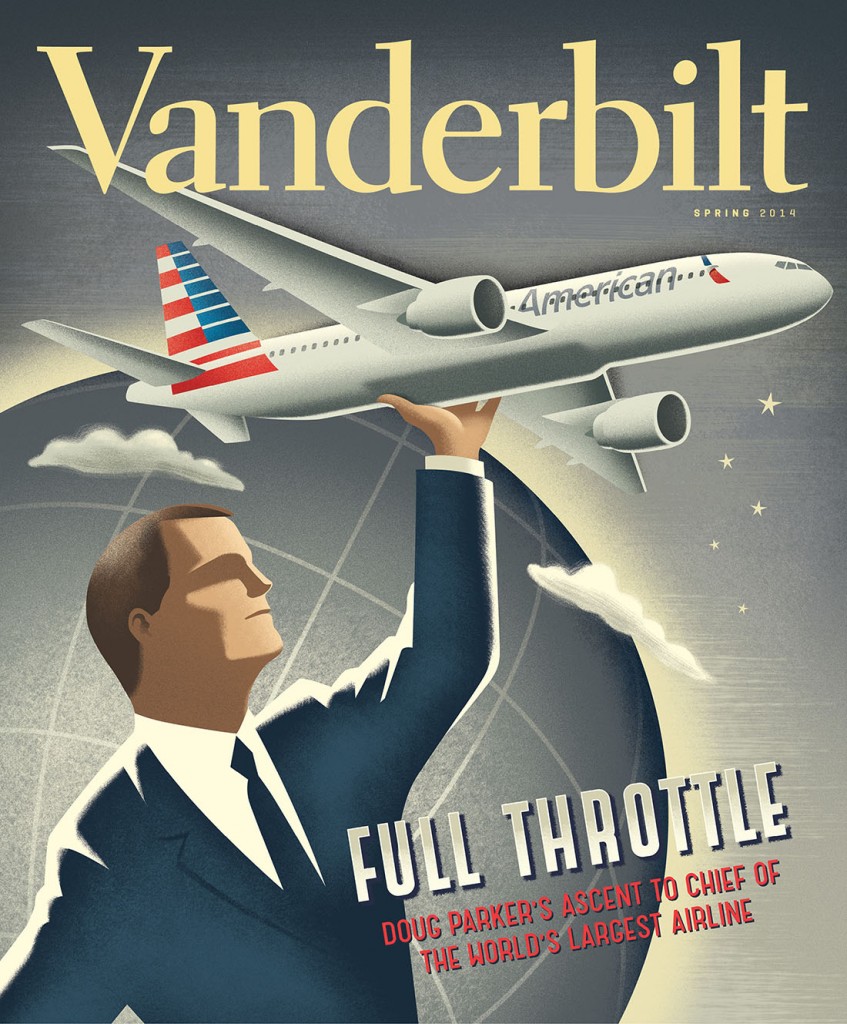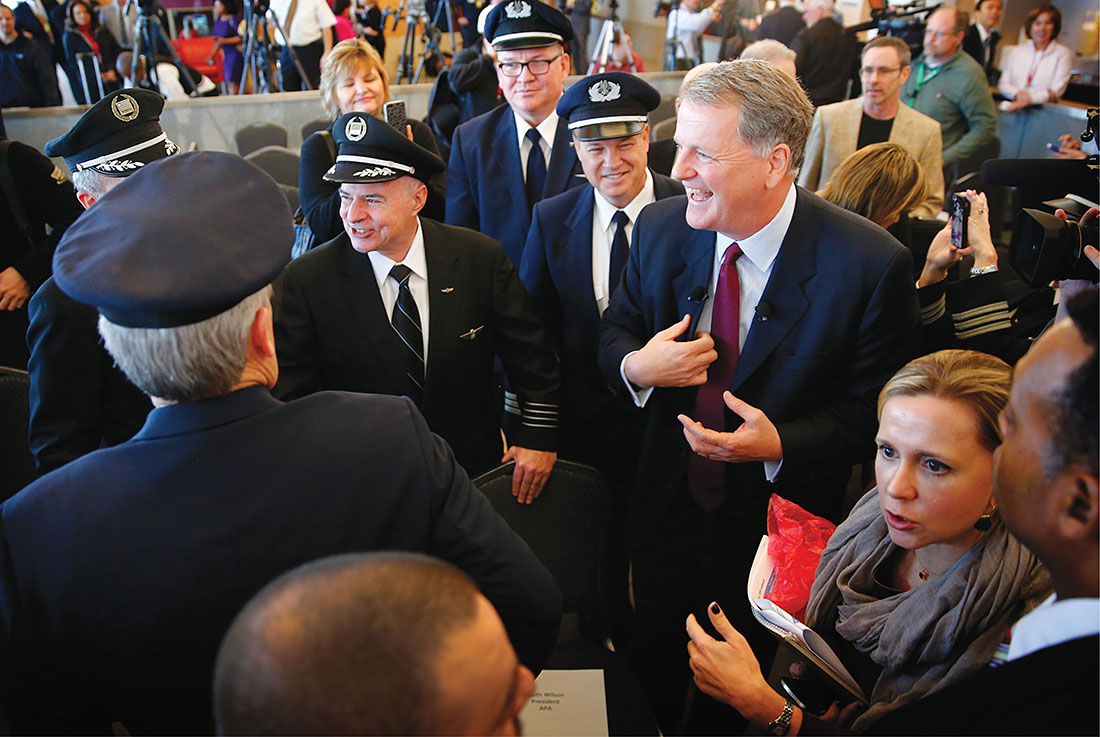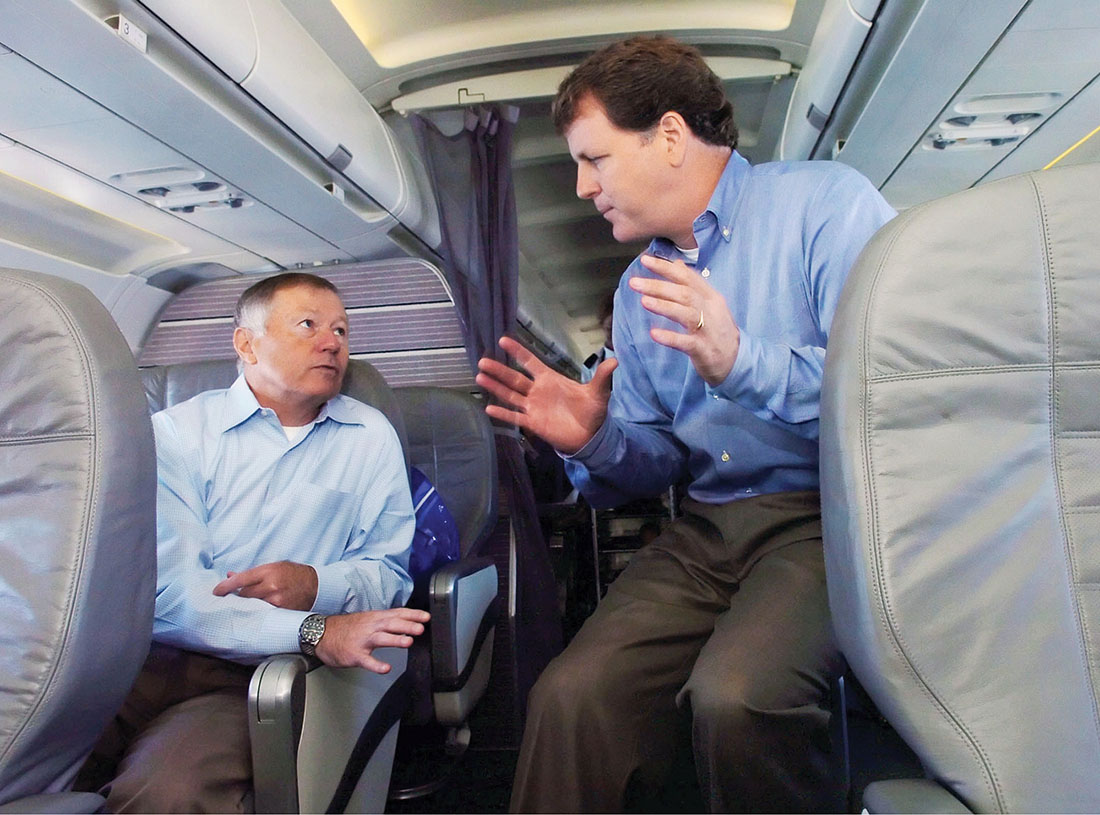
One hundred years ago pilot Tony Jannus made history when he flew a biplane from St. Petersburg, Fla., to neighboring Tampa. By all accounts the flight itself was unremarkable. There were no speed or distance records broken that day, nor feats of aerial acrobatics. In fact, the plane was in the air for just 23 minutes and never rose more than 50 feet above the waters of Tampa Bay.
What drew a crowd of 3,000 onlookers to the shoreline on Jan. 1, 1914—and forever secured Jannus’ place in the annals of aviation lore—was the significance of the passenger riding beside him in the open cockpit: Abram Pheil, the first person ever to pay for a seat on a scheduled airplane flight.
With one short hop across the bay, the age of commercial aviation had officially begun.
Unbeknownst to the participants that day, the inaugural flight of the St. Petersburg–Tampa Airboat Line heralded the coming of a multibillion-dollar industry, of which nearly 9 million flights are operated annually by U.S. passenger airlines. According to the U.S. Department of Transportation, these flights carry roughly 650 million customers around the globe each year.
As astonished as Jannus or Pheil would have been to see the eventual evolution of commercial aviation, it’s equally mystifying for someone like alumnus Doug Parker, CEO of American Airlines Group, to look through the same telescope in reverse. In some sense, those early days seem light years away, he says.
Yet, at the same time, Parker is mindful of his place in commercial aviation history. His ascent to the top spot of the world’s largest airline following a 2013 merger between American Airlines and US Airways is just the latest chapter in an extraordinary century-long story that has seen plenty of ups and downs, both literally and figuratively. Airlines have come and gone, and biplanes have given way to jumbo jets, but the idea behind the business has remained constant throughout.
“It’s still all about getting people safely from point A to point B and having their bags there when they land,” Parker says. “That part hasn’t changed and probably never will.”
A GOOD DAY’S WORK
Parker’s own journey from point A to point B during his career was not a direct flight by any means. As a boy he gave no thought to working for an airline, much less running one.
“A lot of people in this business grew up loving commercial aviation, but I wasn’t one of them,” he says.
Early on, though, he began to develop a nose for business and a strong work ethic, thanks to the influence of his father, William Parker, a division president with The Kroger Co. Each week his father visited the company’s grocery stores across the Midwest and often would invite him to ride along. The trips gave the younger Parker an opportunity to learn firsthand from a man who had worked his way up from the meat counter to the corporate office.
“I learned two things from watching my dad,” he says. “First, when you work for a company, you should make sure you give them a good day’s work. Second, you should always listen to and respect the employees who are interacting with customers.”

The nature of his father’s job meant the family relocated on several occasions, including to Nashville around the time Parker was graduating from Albion College in 1984 with a degree in economics. Unsure about his career options, he decided to enter business school directly, enrolling at nearby Vanderbilt Owen Graduate School of Management.
“Since my parents were paying, the plan was that I’d live at home and attend Vanderbilt. But before I even started, my father got transferred to Dallas. It worked out OK, though, because I didn’t have to live at home as a result,” he says with a laugh.
While at Owen, Parker found that he most enjoyed his finance classes, particularly those taught by Hans Stoll, the Anne Marie and Thomas B. Walker Jr. Professor of Finance, now retired. His interest in finance convinced him to target heavily capitalized businesses for employment because, as he puts it, “that meant finance would be important there. I didn’t want to work at a company that was driven more by, say, its marketing department.”
As it turns out, one such heavily capitalized business, American Airlines, happened to be recruiting on Vanderbilt’s campus that year.
“American was building a hub in Nashville at the time, so they came to recruit on campus,” he says. “After my first interview I flew to Dallas to interview with the whole team. As soon as it was over, I knew it was where I wanted to work. I liked the people I met, and what they did sounded really interesting to me. That’s how I ended up there.”
CATACLYSMIC ISSUES
When Parker started in the finance department at American Airlines in 1986, the competitive landscape in commercial aviation was much more crowded than it is today. And much less efficient, he argues.
“Back then, there were 11 or 12 airlines of comparable size, but none of them could offer customers what they really wanted,” he says. “The most important thing we can provide customers is the ability to take them where they want to go and when they want to get there. If there are 11 or 12 of us but none can take you everywhere you want to fly, that’s a problem.”
After five years with American, Parker landed at Minneapolis-based Northwest Airlines, where he served as vice president and assistant treasurer, and later as vice president of financial planning and analysis. Getting an up-close look at the balance sheet of a second carrier gave him a broader understanding of the tight profit margins and other financial challenges facing commercial aviation at the time.
It also made him resolute in the knowledge that overcoming those challenges was possible. “From the time I started in ’86, people have been talking about how our business isn’t like any other and that it can’t make money,” he says. “They’re right about it not being like other businesses, but the part about not making money never made any sense to me.”
In 1995, Parker left Northwest to join Tempe, Ariz.-based America West Airlines as its chief financial officer. Within five years he became the airline’s president and, soon thereafter, its chairman, president and CEO.
The latter promotion was effective Sept. 1, 2001. As Parker is wont to say, “It was a good 10 days.”
The Sept. 11 terrorist attacks shook the United States to its core, but perhaps no industry felt the reverberations as deeply as commercial aviation. Thousands of flights were canceled in the days immediately after the attacks, and there was prolonged reduction in passenger demand—as high as 30 percent for some carriers. Consequently, some of the country’s largest airlines had to lay off thousands of employees or even file for bankruptcy.
Sept. 11 marked the beginning of a difficult decade for the industry. Financial problems only continued to mount in the ensuing years, culminating in the loss of a combined $26 billion among airlines worldwide in 2008, according to reports issued by the International Air Transport Association (IATA).
“A number of cataclysmic issues have affected our industry—not just 9/11, but fuel prices rising rapidly to $150 a barrel in 2008 and then the Great Recession,” Parker says. “The result has been bankruptcies, liquidations, forcing employees to renegotiate contracts, canceling retirement plans—all sorts of things that were bad not only for our employees but for our customers as well.
“The fact that we couldn’t handle all these issues was a symptom of a larger problem. Ours was a fragile business to begin with.”

HEALTHIER DYNAMIC
The fragile nature of the industry led Parker to become a vocal proponent of airline consolidation. It may mean fewer carriers to choose from, he says, but consolidation actually creates a more competitive marketplace.
“We now have three very competitive airlines—American, United and Delta—who can take you largely anywhere in the world,” Parker says. “And then there are a number of other airlines who provide lower-cost alternatives for consumers on a point-to-point basis, like Southwest and JetBlue. Overall, it’s a much healthier dynamic.”
Industry statistics bear this out, at least from a profitability standpoint. The airlines have seen positive gains every year since 2010, when Delta Air Lines completed its merger with Northwest and United Airlines began the process of acquiring Continental Airlines. According to the IATA, strong earnings should continue in 2014, as global carriers are expected to post a profit of $18.7 billion by year’s end.
Parker himself has overseen mergers twice in his career. The first, which occurred in 2005 between America West and US Airways, resulted in his becoming chairman and CEO of a revamped US Airways Group. The second merger—between US Airways and American in 2013—put him in charge of the world’s largest airline. Headquartered in Fort Worth, Texas, the new American Airlines operates an average of nearly 6,700 flights daily to 339 cities in 54 countries.
Although the $18.1 billion merger with American was significantly larger than the one in 2005, they both followed the same pattern: In each instance, the smaller of the two airlines was the one that assumed control. Having already experienced a reorganization of that nature, Parker and his team were able to make more informed decisions during the 2013 merger.
“With the first merger we implemented many of the systems and procedures that worked at the smaller airline, but that was a mistake,” he says. “This time around we’ve avoided doing anything too disruptive to the larger airline. We’ve found it’s better to change the systems and procedures for just one-third of the organization, not the other way around.”
Mergers inevitably lead to change, including at the top, but Parker has remained steadfast in his commitment to the executive team he’s assembled. In fact, several of the current American Airlines senior officers were part of his management team at America West a decade ago.
Parker believes American’s success depends not so much on any one leader, but rather on the effectiveness of the team as a whole. “For me it’s all about team building,” he says. “I figured out long ago that the best way to get things done is to have a really good team of people. I view myself much more as a coach than a player—one who makes sure we have the best group possible and that they’re motivated and communicating with one another.”
UNASSUMING AND DEVOTED
As dedicated as Parker is to his business team, he puts even more emphasis on his tight circle of family and friends. Andy McCain, BA’84, MBA’86, chief financial officer of Hensley Beverage Co. in Phoenix, has known him since they were classmates at Owen and says that Parker is still one of his closest friends, even though they’re now three decades removed from Vanderbilt.
“I had no idea I would make such a lasting friendship in business school,” says McCain, who serves with Parker on Owen’s Board of Visitors. “Thirty years later we still keep in touch, get together for an occasional trip, and incessantly rib each other on email.”
What makes Parker so likable, says McCain, is that he has remained remarkably down-to-earth even while his career has taken off. “Doug is an unassuming guy,” he says. “Meeting him at Owen was fun because none of us had any sense he would become so successful in his business pursuits. He was pretty shy, but once we got to know him, we learned he was very smart and good-natured, too.”
McCain sees these characteristics reflected in Parker’s home life. “Doug is extremely devoted to his family,” he says. “He and his wife, Gwen, are a great team, and he manages his hectic schedule to make sure he is there for his three kids [Jackson, Luke and Eliza].”
While it’s too early to tell if any of the Parker children will follow their father and mother (a former flight attendant) into the business, the eldest, Jackson, is emulating his father in one respect: He is now a student at Vanderbilt—a member of the Class of 2017, to be exact.
Seeing his son at his alma mater is a gratifying experience for Parker. It also has given him even more pride in the university.
“Knowing what Jackson went through to get into Vanderbilt, I doubt I would be accepted today,” Parker says with characteristic self-effacement. “The university has come so far from when I was there. It’s always been a wonderful place, but the student body is just exceptional, and the team—from Chancellor Zeppos on down—seems intent upon building a truly world-class university and providing a great experience for those kids.”

HERALDING THE UNBELIEVABLE
Parker, too, is intent upon building a world-class organization of his own. While airline consolidation has played a major part in his plan thus far, he points to several other developments that will likely define the industry in the years to come.
One such development is an increased reliance on automation in everything from ticket purchasing to security checkpoints to the flights themselves. Automation, he says, will make the entire process of flying “even easier and more personalized for customers.”
Parker also foresees a return to competing on product—that is, how to best serve the customer in getting from point A to point B. “In the past, we’ve competed more on schedule—who could get you there the fastest,” he says. “Or perhaps only one airline could offer service to a particular destination. But now with three major U.S. airlines, we’ll be competing with each other on who can provide the best service. I think that’s good for everyone.”
Perhaps, though, more than anything else, the industry’s future will be shaped by globalization. “In the years ahead we’ll see increased globalization. There’s no doubt,” he says. “We’ve gone through a lot to get the U.S. airline industry to be more rational, for lack of a better word. Now we’re working on doing the same in the international arena.”
If any industry can claim to be global, it’s commercial aviation. After all, airlines are in the business of spanning vast distances. In this age of technological wonders, the world may be at our fingertips, but air travel is still the only effective means of exploring its farthest reaches in person.
As commercial aviation enters a second century, it’s anyone’s guess how the business will continue to evolve. One hundred years from now, jumbo jets may very well seem like the biplanes of yesteryear, and a flight from New York to London may not take much longer than that historic hop across Tampa Bay.
In this regard, the speech given by one of the promoters to the Tampa crowd in 1914 is just as prescient now as it was then. “What was impossible yesterday is an accomplishment today,” he said, “while tomorrow heralds the unbelievable.”
But however tempting it is to look far ahead, it’s important not to lose sight of the story as a whole. From the humblest of launches, commercial aviation has soared to what was once considered unimaginable heights. There have been dips, turns and pockets of turbulence, to be sure, but it’s been a remarkable ascent nonetheless, with most of humankind going along for the ride.
And to hear Doug Parker tell it, there’s still plenty of room left to climb.